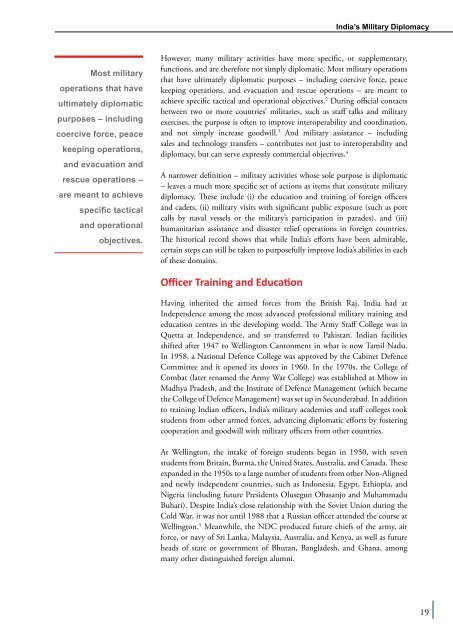Defence Primer
Military_Layout
Military_Layout
You also want an ePaper? Increase the reach of your titles
YUMPU automatically turns print PDFs into web optimized ePapers that Google loves.
India’s Military Diplomacy<br />
Most military<br />
operations that have<br />
ultimately diplomatic<br />
purposes – including<br />
coercive force, peace<br />
keeping operations,<br />
and evacuation and<br />
rescue operations –<br />
are meant to achieve<br />
specific tactical<br />
and operational<br />
objectives.<br />
However, many military activities have more specific, or supplementary,<br />
functions, and are therefore not simply diplomatic. Most military operations<br />
that have ultimately diplomatic purposes – including coercive force, peace<br />
keeping operations, and evacuation and rescue operations – are meant to<br />
achieve specific tactical and operational objectives. 2 During official contacts<br />
between two or more countries’ militaries, such as staff talks and military<br />
exercises, the purpose is often to improve interoperability and coordination,<br />
and not simply increase goodwill. 3 And military assistance – including<br />
sales and technology transfers – contributes not just to interoperability and<br />
diplomacy, but can serve expressly commercial objectives. 4<br />
A narrower definition – military activities whose sole purpose is diplomatic<br />
– leaves a much more specific set of actions as items that constitute military<br />
diplomacy. These include (i) the education and training of foreign officers<br />
and cadets, (ii) military visits with significant public exposure (such as port<br />
calls by naval vessels or the military’s participation in parades), and (iii)<br />
humanitarian assistance and disaster relief operations in foreign countries.<br />
The historical record shows that while India’s efforts have been admirable,<br />
certain steps can still be taken to purposefully improve India’s abilities in each<br />
of these domains.<br />
Officer Training and Education<br />
Having inherited the armed forces from the British Raj, India had at<br />
Independence among the most advanced professional military training and<br />
education centres in the developing world. The Army Staff College was in<br />
Quetta at Independence, and so transferred to Pakistan. Indian facilities<br />
shifted after 1947 to Wellington Cantonment in what is now Tamil Nadu.<br />
In 1958, a National <strong>Defence</strong> College was approved by the Cabinet <strong>Defence</strong><br />
Committee and it opened its doors in 1960. In the 1970s, the College of<br />
Combat (later renamed the Army War College) was established at Mhow in<br />
Madhya Pradesh, and the Institute of <strong>Defence</strong> Management (which became<br />
the College of <strong>Defence</strong> Management) was set up in Secunderabad. In addition<br />
to training Indian officers, India’s military academies and staff colleges took<br />
students from other armed forces, advancing diplomatic efforts by fostering<br />
cooperation and goodwill with military officers from other countries.<br />
At Wellington, the intake of foreign students began in 1950, with seven<br />
students from Britain, Burma, the United States, Australia, and Canada. These<br />
expanded in the 1950s to a large number of students from other Non-Aligned<br />
and newly independent countries, such as Indonesia, Egypt, Ethiopia, and<br />
Nigeria (including future Presidents Olusegun Obasanjo and Muhammadu<br />
Buhari). Despite India’s close relationship with the Soviet Union during the<br />
Cold War, it was not until 1988 that a Russian officer attended the course at<br />
Wellington. 5 Meanwhile, the NDC produced future chiefs of the army, air<br />
force, or navy of Sri Lanka, Malaysia, Australia, and Kenya, as well as future<br />
heads of state or government of Bhutan, Bangladesh, and Ghana, among<br />
many other distinguished foreign alumni.<br />
19


